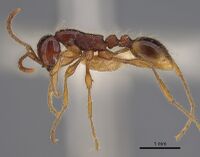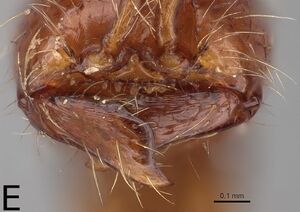Aenictus asantei
| Aenictus asantei | |
|---|---|

| |
| Scientific classification | |
| Kingdom: | Animalia |
| Phylum: | Arthropoda |
| Class: | Insecta |
| Order: | Hymenoptera |
| Family: | Formicidae |
| Subfamily: | Dorylinae |
| Genus: | Aenictus |
| Species group: | asantei |
| Species: | A. asantei |
| Binomial name | |
| Aenictus asantei Campione, Novak & Gotwald, 1983 | |
This species is probably a column raider and was found collecting immatures of a Pheidole species in coastal scrub and grassland habitat.
Identification
Gomez (2022) - A member of the Aenictus asantei species group. The long mandibles crossing one over the other when closed and the presence of some irregular longitudinal rugulae over mesopleurae and propodeum makes this species unmistakable. Its overall size, hairy propodeum and habitus could at first glance resemble Aenictus eugenii, but both can be easily distinguished with the cited mandibular characters.
Keys including this Species
Distribution
Latitudinal Distribution Pattern
Latitudinal Range: 5.66005° to 5.66005°.
| North Temperate |
North Subtropical |
Tropical | South Subtropical |
South Temperate |
- Source: AntMaps
Distribution based on Regional Taxon Lists
Afrotropical Region: Ghana (type locality), Nigeria.
Distribution based on AntMaps
Distribution based on AntWeb specimens
Check data from AntWeb
Countries Occupied
| Number of countries occupied by this species based on AntWiki Regional Taxon Lists. In general, fewer countries occupied indicates a narrower range, while more countries indicates a more widespread species. |

|
Estimated Abundance
| Relative abundance based on number of AntMaps records per species (this species within the purple bar). Fewer records (to the left) indicates a less abundant/encountered species while more records (to the right) indicates more abundant/encountered species. |

|
Biology
Campione et al. (1983) - Behavioral observations on A. asantei were published previously (Gotwald 1976). The species (species A in Gotwald [1976]) was observed on four occasions (colonies GC-027, GC-035, GC-037, GC-047) in coastal scrub and grassland at Legon, Ghana, and once (colony GC-049) crossing a path between plots of cocoa, Theobroma cacao L., in the moist, semideciduous forest region at Jukwa, Ghana. All five colonies were collected in heavily cultivated habitats. The four colonies found at began, the type-locality, were in columns moving near or in plots planted with cassava, Manihot esculenta Crantz, in the University of Ghana farm system.
A. asantei is probably a column raider (a column raid consists of a system of branching columns that usually terminate in small groups of advancing workers engaged in foraging activities), although on two occasions (colonies GC-035 and GC-037) the workers were traveling in a series of anastomosing columns that merged to form a single base column, reminiscent of the swarm raiding patterns of the driver ants of the army ant genus Doryus. In these two cases, the workers were traveling unidirectionally toward the base column, presumably toward the colony nest. The base columns varied from one to four workers in width, and some workers in each carried prey. Each trunk column entered a hole in the soil. The column of colony GC-037 was lined on both sides with clustered workers for the last 10 cm before the column made its subterranean descent. Colonies GC-027 and GC-049 were each observed as columns consisting of a single file of workers. The prey collected from colony GC-037 consisted of immature forms of the ant Pheidole sp. and included 24 worker pupae and 3 larvae. Although colony GC-047 was emigrating, several workers carried prey, all adults of Pheidole. The prey items included one queen, two workers, three worker heads, and one mesosoma.
The emigrating column of colony GC-047 was discovered at 0950 h. A detailed description of the emigration can be found in Gotwald (1976).
Morphology
Campione, Novak and Gotwald (1983) provide a detailed description of the internal morphology of a worker with numerous histological images.
Castes
Table of known castes for all Afrotropical Aenictus species.
Worker
Holotype images at MCZBASE (https://mczbase.mcz.harvard.edu/guid/MCZ:Ent:33040)
Queen
Nomenclature
The following information is derived from Barry Bolton's Online Catalogue of the Ants of the World.
- asantei. Aenictus asantei Campione, Novak & Gotwald, 1983: 873, 7 figs. (w.q.) GHANA.
- Type-material: holotype worker, paratype workers (number not stated), 1 paratype queen.
- Type-locality: holotype Ghana: University of Ghana, Legon, 27.vi.1971, GC-047, on cultivated land (B.M Campione, et al.); paratypes with same data.
- Type-depositories: MCZC (holotype); BMNH, MCZC, MNHN, ROMT (paratypes).
- [Note: Gómez, 2022: 17, says paratypes could not be found in BMNH, MNHN.]
- Status as species: Bolton, 1995b: 58; Gómez, 2022: 17 (redescription).
- Distribution: Ghana.
Unless otherwise noted the text for the remainder of this section is reported from the publication that includes the original description.
Description
Worker
Total length 3.47-3.89 mm; head, alitrunk, waist, and gaster dark reddish brown to reddish orange;legs and antennae orange-brown to yellow-orange; bullae of metapleural glands yellow, especially conspicuous in darkly pigmented individuals. Pilosity moderately abundant, consisting of erect to suberect setae.
Head length 0.63-0.77 mm; head width 0.63-0.72 mm; cephalic index (HW/HL X 100) 93.5-107.9. Head glossy, without obvious punctures; parafrontal ridges (elevated lines extending longitudinally from clypeus laterad to the antenna! fossae) well developed, each terminating in a minute spine. Frontal carinae expanded anteriorly to form thin flanges projecting dorsally; clypeus bearing distinct serial teeth; occipital collar present; eyes absent. Antenna 10-segmented, scape length 0.54-0.63 mm. Mandible flattened, linear, striolate, with sharp apical tooth; subapical teeth absent, although some denticles. may be present. Labrum bilobed with smoothly rounded median cleft; maxillary palpus two-segmented; lateral shoulder of stipes bearing three stout setae; stipes without transverse stipital groove; galea crown flattened, invested with numerous setae; maxillary comb typical; lacinial apex bearing numerous, irregularly placed, fine setae; labial palpus two-segmented.
Alitrunk length I. 10-1.26 mm; without conspicuous suturing. Pronotum glossy except for anterior dorsal slope, this densely punctate; posterior two-thirds of alitrunk subopaque with well-developed longitudinal rugae, especially on pleurae; propodeal junction marked by sharply produced ridge extending laterally and bordering declivitous face of propodeum; declivitous face densely punctate.
Petiole and postpetiole: waist (petiole plus postpetiole) length 0.63-0.68 mm; petiole node length 0.29-0.36 mm, width 0.18-0.27 mm; postpetiolar node length 0.27-0.36 mm, width 0.20-0.27 mm. Waist opaque, densely punctate; subpetiolar process triangular with rounded apex, usually directed ventrally or posteriorly. Gaster length 1.13-1.26 mm.
Gaster glossy, lacking obvious punctures.
Tarsal claws simple.
Gomez (2022) - HL: 0.72 [0.70-0.74]; HW: 0.70 [0.67-0.72]; SL: 0.58 [0.56-0.60]; WL: 1.24 [1.18-1.29]; PL: 0.29 [0.27-0.29]; PH: 0.22 [0.20-0.22]; PPL: 0.26 [0.25-0.26]; PPH: 0.18 [0.17-0.19]; CS: 0.71 [0.68-0.73]; CI: 97 [95-101]; SIL: 80 [80-81]; SIW: 82 [80-84]; WL/HW: 175 [171-178]; PI: 130 [122-134]; PPI: 141 [131-147]; CSR: 106; (n=5).
Campione et al. (1983) offers an accurate description for both worker and queen castes. One of the biggest Afrotropical Aenictus species (HW~0.74, WL~1.26). Mandibles long, one closing tight against the clypeus with the apical tooth surpassing the opposite antennal insertion, and the other mandible crossed over it at an angle; apical tooth present, without preapical, sometimes (but not usually) followed by small denticles. Frontal ridges not fused, expanded in its laterobasal corner into a big projecting rounded triangle clearly visible in lateral or dorsal views. Parafrontal ridge present but weak. Ventrolateral margin present and extending ventrally to approximately half head’s length. Petiole with anterolateral and anterodorsal ridges present, sometimes a parallel ridge runs from the propodeal spiracle to the anterolateral ridge. Propodeal ridge developed and projecting, clearly visible in dorsal view. Petiole subsessile. subpetiolar process from elliptical to triangular, rounded, oriented downwards.
Head, pronotum, mesonotum, gaster, scapes and legs glassy smooth, mesopleurae and lateropropodeum longitudinally rugulose, dorsopropodeum from smooth to rugulose. Petiole with 1–2 (at most) horizontal rugulae extending horizontally at spiracle height, another maybe present dorsally. Petiole and postpetiole densely punctated.
Orange to dark brown. Whole body (including propodeal dorsum) covered with similar, abundant, very long greyish setae, the longest as long as petiole height. No pubescence noted.
Queen
Total length 9 .86 mm; head , alitrunk, waist, and gaster reddish orange; legs yellow-orange. Pilosity moderately abundant.
Head length (excluding mandibles) 1.44 mm; head width 1.50 mm; cephalic index I 04. I. Head glossy, without obvious punctures; frontal carinae forming flanges on antero-mesal boundaries of antennal fossae; clypeus bearing teeth irregular in shape and length; one median ocellus present. Antenna 10-segmented, scape length 0.72 mm. Mandible linear without subapical teeth; labrum bilobed with smoothly rounded median cleft.
Alitrunk glossy without obvious punctures. Pronotum carapace-like, continuous, with slightly elevated mesonotum ; metanotum not distinguishable; alitrunk without conspicuous suturing; propodeal junction smoothly rounded.
Petiole length 0.90 mm; petiole width 0.90 mm; petiolar node length 0 .72 mm. Petiole glossy without obvious punctures; subpetiolar process triangular with rounded, posteriorly directed apex.
Gaster length 5. I 8 mm. Gaster glossy without obvious punctures; pygidium armed with lateral spines.
Type Material
- Holotype, GHANA: Legon, University of Ghana (8mi. N Accra) (1w) [MCZC:ENT:33040] MCZC [Images examined only, material seen on web by Gomez, 2022]. The types deposited at MNHN and BMNH (CAMPIONE et al., 1983) couldn't be found by Gomez (2022), so his diagnosis was based on workers from the type locality checked against the Holotype images at MCZBASE (https://mczbase.mcz.harvard.edu/guid/MCZ:Ent:33040).
Etymology
This species is named for the Asante people of Ghana.
Determination Clarifications
Species A in Gotwald 1976.
References
- Campione, B. M.; Novák, J. A.; Gotwald, W. H., Jr. 1983. Taxonomy and morphology of the West African army ant, Aenictus asantei n. sp. (Hymenoptera: Formicidae). Ann. Entomol. Soc. Am. 76: 873-883.(page 873, figs. worker, queen described)
- Gomez, K. 2022. A revision of the Afrotropical species of the Dorylinae ant genus Aenictus (Hymenoptera: Formicidae) based on the worker caste. Belgian Journal of Entomology 124: 1–86 (doi:10.5281/zenodo.5898821).
- Gotwald, W.H., Jr. 1976. Behavioral observations on African army ants of the genus Aenictus (Hymenoptera: Formicidae). Biotropica 8: 59-65.
References based on Global Ant Biodiversity Informatics
- Campione B.M., J.A. Novak, W.H.Jr. Gotwald. 1983. Taxonomy and morphology of the West African army ant, Aenictus asantei n. sp. (Hymenoptera: Formicidae). Annals of the Entomological Society of America 76:873-883.





